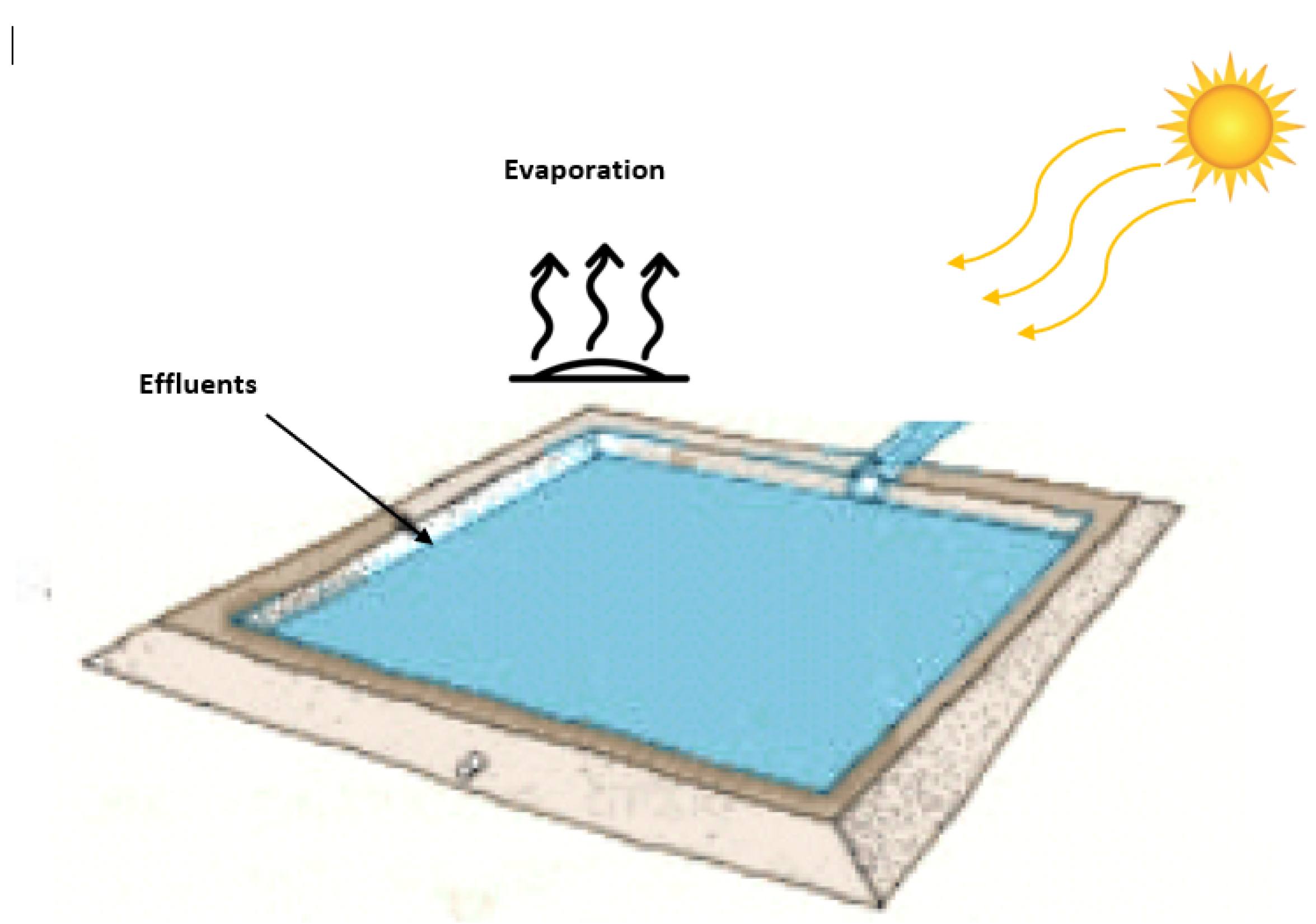A Sustainable Concept for Recovering Industrial Wastewater Using Adjustable Green Resources †
Abstract
:1. Introduction
2. Material and Methods
2.1. Study Area
2.2. Effluent Physicochemical Analysis
2.3. Regression Analysis
3. Results and Discussion
3.1. Physicochemical Results
3.2. Regression Results
4. Conclusions
Author Contributions
Funding
Institutional Review Board Statement
Informed Consent Statement
Data Availability Statement
Conflicts of Interest
References
- Abdeljalil, A.; Nabil, S.; Rachid, M. Feasibility and Sustainability of Evaporation Ponds as Final Basins for Industrial Wastewater: Statistical Evaluation of Gross Parameters. Desalination Water Treat. 2022, 257, 41–54. [Google Scholar] [CrossRef]
- Ahmed, M.; Shayya, W.H.; Hoey, D.; Mahendran, A.; Morris, R.; Al-Handaly, J. Use of Evaporation Ponds for Brine Disposal in Desalination Plants. Desalination 2000, 130, 155–168. [Google Scholar] [CrossRef]
- Adam, A.; Saffaj, N.; Mamouni, R.; Baih, M. Characterization of industrial Wastewater Physico-Chemical Properties. Int. J. Tech. Phys. Probl. Eng. 2022, 14, 219–227. [Google Scholar]
- Lrhoul, H.; Assaoui, N.E.; Turki, H. Mapping of Water Research in Morocco: A Scientometric Analysis. Mater. Today Proc. 2021, 45, 7321–7328. [Google Scholar] [CrossRef]
- Sow, A.; Traore, I.; Diallo, T.; Traore, M.; Ba, A. Comparison of Gaussian Process Regression, Partial Least Squares, Random Forest and Support Vector Machines for a near Infrared Calibration of Paracetamol Samples. Results Chem. 2022, 4, 100508. [Google Scholar] [CrossRef]
- Halconruy, H.; Marie, N. Kernel Selection in Nonparametric Regression. Math. Methods Stat. 2020, 29, 32–56. [Google Scholar] [CrossRef]
- Moroccan Limit-Values-of-Discharges. Available online: http://www.environnement.gov.ma/fr/78-cat1/1012-valeurs-limites-des-rejets (accessed on 15 July 2017).
- Abdeljalil, A.; Nabil, S.; Rachid, M. Contribution to Developing an Environmental Emergency Response for Industrial Sites. J. Environ. Agric. Stud. 2021, 2, 97–102. [Google Scholar] [CrossRef]



| Parameter | Unit | Limit | 11/21 | 12/21 | 01/22 | 02/22 | 03/22 | 04/22 | 05/22 | 06/22 | 07/22 | 08/22 | 09/22 | 10/22 |
|---|---|---|---|---|---|---|---|---|---|---|---|---|---|---|
| pH | pH unit | 5.5–9.5 | 8.1 | 7.9 | 7.6 | 7.9 | 8.0 | 7.5 | 7.6 | 8.1 | 8.1 | 7.1 | 7.7 | 8.0 |
| EC | ms/cm | 2.7 | 9 | 18 | 19 | 23 | 38 | 18 | 45 | 26 | 33 | 28 | 44 | 36 |
| SO₄ | mg/L | 600 | 1800 | 1840 | 2320 | 1985 | 1300 | 3500 | 2900 | 4256 | 1987 | 2692 | 2569 | 4200 |
| TSS | mg/L | 100 | 102 | 79 | 105 | 129 | 153 | 304 | 215 | 116 | 98 | 197 | 203 | 171 |
| COD | mg O2/L | 500 | 356 | 620 | 560 | 519 | 614 | 652 | 498 | 516 | 563 | 578 | 452 | 512 |
| BOD5 | mg O2/L | 100 | 95 | 120 | 95 | 115 | 118 | 103 | 142 | 109 | 98 | 102 | 115 | 124 |
| Y: Dependent | X: Independent | Correlation ® | R² | a | B (Constant) | Regression Equation (Y = ax + b) |
|---|---|---|---|---|---|---|
| TSS | pH | −0.603 | 0.364 | −127.88 | 1153.5 | TSS = −127.88 pH + 1153.5 |
| TSS | SO4 | 0.415 | 0.172 | 0.028 | 81.68 | TSS = 0.028 SO4 + 81.68 |
| TSS | EC | 0.314 | 0.098 | 1.81 | 105.13 | TSS = 1.81 EC + 105.13 |
| BOD5 | EC | 0.649 | 0.422 | 0.79 | 88.91 | BOD5 = 0.79 EC + 88.91 |
| COD | pH | −0.319 | 0.1023 | −84.03 | 1192.2 | COD = −84.03 pH + 1192.2 |
Disclaimer/Publisher’s Note: The statements, opinions and data contained in all publications are solely those of the individual author(s) and contributor(s) and not of MDPI and/or the editor(s). MDPI and/or the editor(s) disclaim responsibility for any injury to people or property resulting from any ideas, methods, instructions or products referred to in the content. |
© 2023 by the authors. Licensee MDPI, Basel, Switzerland. This article is an open access article distributed under the terms and conditions of the Creative Commons Attribution (CC BY) license (https://creativecommons.org/licenses/by/4.0/).
Share and Cite
Adam, A.; Saffaj, N.; Mamouni, R. A Sustainable Concept for Recovering Industrial Wastewater Using Adjustable Green Resources. Environ. Sci. Proc. 2023, 25, 60. https://doi.org/10.3390/ECWS-7-14302
Adam A, Saffaj N, Mamouni R. A Sustainable Concept for Recovering Industrial Wastewater Using Adjustable Green Resources. Environmental Sciences Proceedings. 2023; 25(1):60. https://doi.org/10.3390/ECWS-7-14302
Chicago/Turabian StyleAdam, Abdeljalil, Nabil Saffaj, and Rachid Mamouni. 2023. "A Sustainable Concept for Recovering Industrial Wastewater Using Adjustable Green Resources" Environmental Sciences Proceedings 25, no. 1: 60. https://doi.org/10.3390/ECWS-7-14302
APA StyleAdam, A., Saffaj, N., & Mamouni, R. (2023). A Sustainable Concept for Recovering Industrial Wastewater Using Adjustable Green Resources. Environmental Sciences Proceedings, 25(1), 60. https://doi.org/10.3390/ECWS-7-14302






